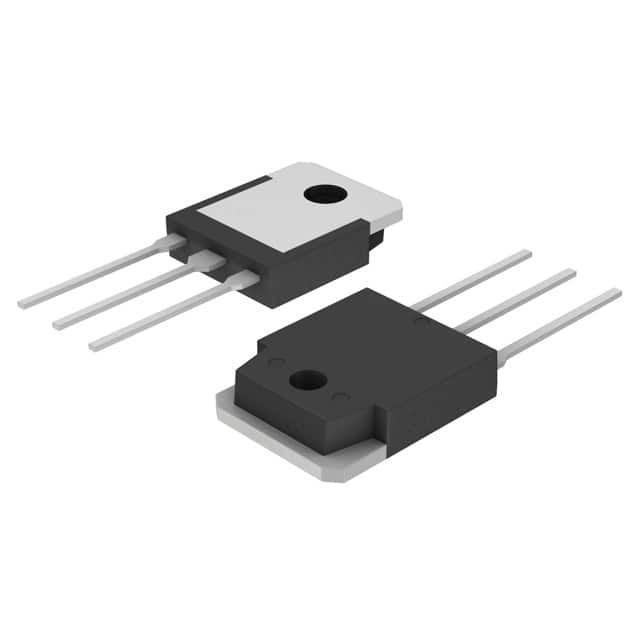MBR3045PT-E3/45
Product Overview
The MBR3045PT-E3/45 belongs to the category of Schottky Barrier Rectifiers. It is commonly used in power supply applications and exhibits characteristics such as high current capability, low forward voltage drop, and fast switching speed. The package type for this product is TO-247AD, and it is available in tape and reel packaging with a quantity of 450 units per reel.
Specifications
- Maximum Average Forward Current: 30A
- Peak Forward Surge Current: 200A
- Reverse Voltage: 45V
- Operating Junction Temperature Range: -65°C to +175°C
Detailed Pin Configuration
The MBR3045PT-E3/45 has a TO-247AD package with three pins: 1. Pin 1: Anode 2. Pin 2: Cathode 3. Pin 3: Anode
Functional Features
- High current capability
- Low forward voltage drop
- Fast switching speed
- Guard ring for enhanced ruggedness and long-term reliability
Advantages and Disadvantages
Advantages
- Efficient power conversion
- Enhanced reliability due to guard ring technology
- Suitable for high-frequency applications
Disadvantages
- Higher cost compared to standard rectifiers
- Sensitive to reverse voltage spikes
Working Principles
The MBR3045PT-E3/45 operates based on the Schottky barrier principle, where the metal-semiconductor junction provides fast switching and low forward voltage drop characteristics. When a forward voltage is applied, the barrier height determines the rectification properties, allowing for efficient power conversion.
Detailed Application Field Plans
The MBR3045PT-E3/45 is widely used in various applications including: - Switching power supplies - DC-DC converters - Freewheeling diodes - OR-ing diodes - Reverse battery protection
Detailed and Complete Alternative Models
Some alternative models to MBR3045PT-E3/45 include: - MBR2045PT-E3/45 - MBR3045PT-E3/81 - MBR3060PT-E3/45 - MBR30100PT-E3/45
In conclusion, the MBR3045PT-E3/45 Schottky Barrier Rectifier offers high current capability, low forward voltage drop, and fast switching speed, making it suitable for various power supply applications. Its efficiency and reliability make it a preferred choice in the industry, despite its higher cost and sensitivity to reverse voltage spikes. With its detailed specifications, pin configuration, functional features, advantages, disadvantages, working principles, application field plans, and alternative models, the MBR3045PT-E3/45 provides a comprehensive solution for power conversion needs.
Senaraikan 10 soalan dan jawapan biasa yang berkaitan dengan aplikasi MBR3045PT-E3/45 dalam penyelesaian teknikal
What is the MBR3045PT-E3/45 used for?
- The MBR3045PT-E3/45 is a Schottky diode commonly used in power supply and voltage regulation applications.
What are the key specifications of the MBR3045PT-E3/45?
- The MBR3045PT-E3/45 has a maximum average forward current of 30A, a reverse voltage of 45V, and a low forward voltage drop.
How does the MBR3045PT-E3/45 compare to other diodes in its class?
- The MBR3045PT-E3/45 offers lower forward voltage drop and faster switching compared to standard diodes, making it suitable for high-frequency applications.
Can the MBR3045PT-E3/45 be used in parallel to handle higher currents?
- Yes, the MBR3045PT-E3/45 can be used in parallel to increase the current-handling capability in power supply designs.
What are the typical applications of the MBR3045PT-E3/45?
- The MBR3045PT-E3/45 is commonly used in DC-DC converters, reverse polarity protection circuits, and battery charging systems.
Does the MBR3045PT-E3/45 require a heatsink in high-power applications?
- In high-power applications, it is recommended to use a heatsink to dissipate heat and ensure optimal performance of the MBR3045PT-E3/45.
What are the advantages of using the MBR3045PT-E3/45 in power supply designs?
- The MBR3045PT-E3/45 offers low forward voltage drop, fast switching speed, and high efficiency, making it ideal for power conversion applications.
Are there any specific layout considerations when using the MBR3045PT-E3/45 on PCBs?
- It is important to minimize the length of traces between the diode and the load or source to reduce voltage drops and EMI effects.
Can the MBR3045PT-E3/45 be used in automotive electronics applications?
- Yes, the MBR3045PT-E3/45 is suitable for automotive electronics due to its rugged construction and high temperature operation capabilities.
Where can I find detailed application notes and reference designs for the MBR3045PT-E3/45?
- Detailed application notes and reference designs for the MBR3045PT-E3/45 can be found on the manufacturer's website or in the product datasheet.


